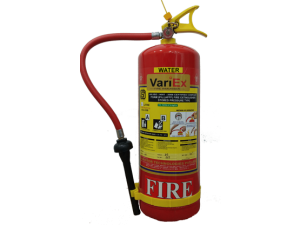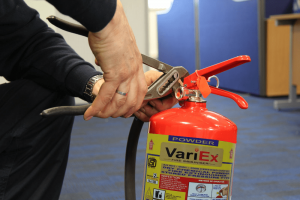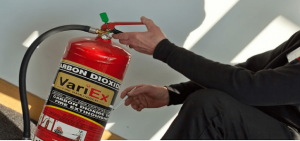![]()
Fire Immuniser
+91-7829629111
Email: info@variex.in
Varistor Technologies Pvt. Ltd.
Block-1, First Floor, Ardente Office One, Hoodi Circle, ITPL Main Road, Bengaluru, Karnataka 560048, IN
How to Refill Water Fire Extinguishers: A Simple Guide for Everyone!
Water fire extinguishers emerge as stalwart guardians against the unpredictable dance of flames. Simple yet effective, these extinguishers utilize the power of water to quell fires fueled by common combustibles like wood, paper, and cloth. Their importance cannot be overstated, especially in settings where traditional materials pose a significant fire risk. As indispensable allies in our firefighting arsenal, water fire extinguishers demand our attention when it comes to maintenance and refilling. In this comprehensive guide, 'How to Refill a Water Fire Extinguishers: A Simple Guide for Everyone!', we'll unravel the intricacies of refilling water fire extinguishers, breaking down what might seem like a daunting task into simple, easy-to-follow steps. Whether you're a seasoned safety enthusiast or a novice looking to enhance your fire preparedness, this guide is crafted for everyone. So, let's embark on a journey to demystify the process and empower you to keep your water fire extinguisher ready for action when the need arises. Because when it comes to fire safety, every step we take contributes to a safer, more secure environment for ourselves and those around us.
Knowing When Your Extinguisher Needs Refilling
The water fire extinguisher stands as a vigilant guardian, ready to quell flames with its simple yet potent arsenal. However, even the most reliable defenders require our attention, and knowing when your extinguisher needs a refill is paramount in maintaining its effectiveness. Let's explore the telltale signs that signal your water fire extinguisher may be due for a recharge and underscore the importance of regular checks in the tapestry of fire safety.
Clear Signs of Refill Necessity:
- Low Pressure on the Gauge: One of the most straightforward indicators that your water fire extinguisher is running low is the pressure gauge. If the needle hovers in the red or below the recommended level, it's a clear signal that the extinguisher needs a refill. Adequate pressure is crucial for ensuring that the water discharges effectively when combating a fire.
- Visible Damages: A visual inspection can reveal a multitude of insights into the health of your extinguisher. Cracks, dents, or any form of visible damage may compromise the structural integrity of the extinguisher, indicating that a refill or replacement may be in order.
- Expired Extinguisher Tags: Every water fire extinguisher comes with a tag indicating its expiration date. If this date has passed, it's time to consider a refill. The chemicals inside the extinguisher may lose their potency over time, diminishing the extinguisher's ability to effectively combat fires.
- Residue or Rust: A closer look at the nozzle or the body of the extinguisher might reveal residue or rust. These are signs that the internal components may be compromised, hindering the extinguisher's performance. In such cases, a refill is essential to ensure optimal functionality.
The Significance of Regular Checks:
Regular checks for your water fire extinguisher are not merely a formality but a proactive measure in fire safety. They serve as a preventative measure, allowing you to identify potential issues before they escalate. By incorporating routine inspections into your safety regimen, you become an active participant in ensuring the reliability of your firefighting tool. In the unpredictable landscape of fire hazards, early detection of extinguisher issues can make a significant difference. It transforms your extinguisher from a passive safety measure to an active, dependable ally. Regular checks, coupled with timely refills, contribute to a robust fire safety strategy, ensuring that when the flames leap unexpectedly, your water fire extinguisher stands poised and ready to protect lives and property.
Safety Precautions Before Refilling water type fire extinguishers
The process of refilling water-type fire extinguishers demands meticulous attention to safety. Before embarking on the crucial task of replenishing your firefighting ally, it's imperative to fortify the environment with necessary safety measures. Creating a secure space ensures not only the effectiveness of the refill process but also safeguards against potential hazards.
Understanding the Gravity:
Before delving into the intricacies of the refill, it's crucial to grasp the gravity of the task at hand. Refilling water-type fire extinguishers involves handling pressurized equipment and potentially volatile substances. Recognizing the inherent risks underscores the importance of taking comprehensive safety precautions.
Protective Gear:
Equipping oneself with the appropriate protective gear is akin to donning armor before entering a battlefield. Safety goggles shield the eyes from potential splashes or chemical reactions, while gloves provide a protective barrier against skin contact with extinguishing agents. Wearing suitable clothing, preferably long sleeves and pants, adds an extra layer of defense.
Ventilation Considerations:
Ensuring proper ventilation in the refill environment is not just a comfort measure; it's a fundamental safety consideration. Adequate airflow minimizes the risk of inhaling fumes or vapors that may be emitted during the refill process. It's a preemptive measure against respiratory irritation and contributes to a safer working environment.
Secure Surroundings:
Before commencing the refill, securing the surroundings is paramount. Clear the area of any potential obstructions or combustible materials. The refill process involves pressurized release, and a clutter-free space minimizes the risk of accidents or mishaps. It's a proactive step in fostering a controlled environment for the task at hand.
Emergency Response Planning:
Anticipation is the cornerstone of effective safety measures. Before starting the refill, having a well-thought-out emergency response plan is imperative. Knowing the location of emergency exits, having a fire extinguisher nearby, and understanding evacuation procedures contribute to a comprehensive safety net.
Professional Guidance:
In the intricate landscape of fire safety, seeking professional guidance is not a sign of incapability but a testament to responsibility. If unsure about the refill process or safety measures, consulting with experts ensures that the task is undertaken with precision and adherence to safety standards.
Materials and Tools Needed for Refilling
To refilling a water-type fire extinguisher, preparedness is key. Having the right materials and tools at your disposal ensures a smooth and effective refill process. Let's explore the essential components required for this task, from the necessary materials to the tools that facilitate a safe and efficient refill.
Materials Needed:
- Water-Compatible Fire Extinguishing Agent: The primary material for refilling a water-type fire extinguisher is the extinguishing agent itself. This agent is typically a specially formulated solution that enhances the water's effectiveness in suppressing fires. Ensuring that the agent is compatible with water extinguishers is crucial for optimal performance.
- Pressurized Air or Nitrogen: To create the necessary pressure for discharging the water and extinguishing agent, a source of pressurized air or nitrogen is required. This pressurized gas is a vital material for maintaining the functionality of the extinguisher.
- Funnel or Filling Hose: A funnel or filling hose facilitates the controlled transfer of the extinguishing agent into the water-type fire extinguisher. This ensures precision during the refill process, minimizing the risk of spillage.
- Measuring Tools: Accurate measurements are essential to achieve the right concentration of the extinguishing agent in the water. Measuring tools, such as graduated cylinders, help in achieving the correct ratios for an effective firefighting solution.
- Protective Seals and Gaskets: Seals and gaskets play a critical role in maintaining the integrity of the pressurized system within the fire extinguisher. Having replacement seals on hand ensures that any worn or damaged components can be promptly replaced during the refill process.
Tools and Equipment:
- Adjustable Wrenches: These tools are essential for safely removing and securing components of the fire extinguisher during the refill process. Adjustable wrenches provide versatility in handling different-sized nuts and bolts.
- Pressure Gauge: A pressure gauge allows for accurate monitoring of the pressure levels within the fire extinguisher. It serves as a crucial tool in ensuring that the extinguisher is pressurized to the recommended levels for effective firefighting.
- Safety Goggles and Gloves: Personal protective equipment is vital during the refill process. Safety goggles protect the eyes from potential splashes, while gloves provide a barrier against skin contact with the extinguishing agent and other materials.
- Ventilation Equipment: As safety is paramount, proper ventilation equipment, such as exhaust fans or airflow systems, helps in dissipating any fumes or vapors that may be emitted during the refill process. This contributes to a safer working environment.
- Fire Extinguisher Bracket or Holder: A bracket or holder secures the fire extinguisher in place, preventing accidental displacement during the refill. This simple tool adds an extra layer of safety to the process.
Step-by-Step Refilling Process of water type fire extinguishers
Refilling a water-type fire extinguisher might sound like a daunting task, but with a step-by-step guide and a few tips up your sleeve, it can be a manageable process. Let's dive into a detailed walkthrough of the refill procedure, ensuring a smooth and effective recharge of your firefighting ally.
Step 1: Gather the Materials and Tools
Before you start, ensure you have all the necessary materials and tools at hand – the water-compatible extinguishing agent, pressurized air or nitrogen, a funnel or filling hose, measuring tools, and protective seals and gaskets. Equip yourself with adjustable wrenches, a pressure gauge, safety goggles, gloves, and proper ventilation equipment.
Step 2: Safety First
Don your safety gear – safety goggles to protect your eyes and gloves to shield your hands. Ensure proper ventilation in the refill area to minimize exposure to fumes or vapors. Safety is paramount throughout the process.
Step 3: Remove the Extinguisher from its Mounting
Use adjustable wrenches to safely detach the water-type fire extinguisher from its mounting bracket or holder. This step ensures easy access for the refill process.
Step 4: Depressurize the Extinguisher
Before opening the extinguisher, depressurize it by discharging any remaining pressure. This can be done by activating the extinguisher until it's fully discharged.
Step 5: Remove the Valve Assembly
Use adjustable wrenches to carefully remove the valve assembly. This step allows access to the interior of the extinguisher for the refill.
Step 6: Measure and Pour the Extinguishing Agent
Utilize measuring tools to ensure accurate proportions, then use a funnel or filling hose to pour the water-compatible extinguishing agent into the extinguisher. Follow the recommended ratios for the specific extinguishing agent you are using.
Step 7: Reattach the Valve Assembly
Securely reattach the valve assembly, ensuring a snug fit. Replace any seals or gaskets as needed to maintain the integrity of the pressurized system.
Step 8: Pressurize the Extinguisher
Introduce pressurized air or nitrogen into the extinguisher until it reaches the recommended pressure level. Use a pressure gauge to monitor and adjust as necessary.
Step 9: Test the Refilled Extinguisher
Perform a test discharge in a safe and controlled manner to ensure the proper functioning of the refilled water-type fire extinguisher.
Tips and Tricks for a Smooth Refill:
- Follow Manufacturer Guidelines: Adhere to the manufacturer's guidelines and recommendations for the specific water-type fire extinguisher model you are refilling.
- Precision in Measurements: Accurate measurements of the extinguishing agent are crucial for the effectiveness of the refill. Use graduated cylinders or other measuring tools for precision.
- Systematic Approach: Follow a systematic approach, ensuring each step is completed before moving on to the next. This reduces the risk of oversights during the refill process.
- Careful Handling: Handle the extinguisher components with care, especially when removing or reattaching the valve assembly. Avoid unnecessary force to prevent damage.
- Regular Maintenance: Incorporate regular maintenance into your fire safety routine to detect any potential issues before they escalate. This proactive approach contributes to the longevity and reliability of your water fire extinguisher.
Common Mistakes to Avoid during the refilling process
Understanding the common mistakes made during the refill process is crucial for maintaining the effectiveness of these firefighting tools. Let's delve into the identification of these errors and explore valuable tips on how to prevent and rectify them, ensuring a seamless and reliable recharge.
1. Inaccurate Measurement of Extinguishing Agent:
One prevalent mistake lies in inaccurate measurements of the extinguishing agent. Failing to precisely measure the proportions can compromise the extinguisher's ability to effectively combat fires. To prevent this, use graduated cylinders or measuring tools to ensure the correct ratios, adhering to manufacturer guidelines.
2. Neglecting Safety Precautions:
Safety should never be an afterthought. Neglecting to don proper safety gear, including safety goggles and gloves, is a critical mistake. To prevent potential hazards, always prioritize safety. Additionally, ensure proper ventilation to mitigate exposure to fumes during the refill process.
3. Rushing the Depressurization Step:
In the haste to initiate the refill, rushing the depressurization step can lead to oversights. Failing to discharge the remaining pressure fully can pose risks during subsequent steps. To prevent this, take the time to ensure the extinguisher is depressurized entirely before proceeding.
4. Mishandling Components:
Mishandling extinguisher components, especially during the removal and reattachment of the valve assembly, is a common error. Applying excessive force or overlooking the delicate nature of these components can result in damage. Prevent mishandling by approaching each step with care and precision.
5. Disregarding Manufacturer Guidelines:
Overlooking or disregarding manufacturer guidelines is a mistake that can have repercussions. Each water-type fire extinguisher model may have specific requirements, and ignoring these guidelines can lead to inefficiencies in the refill. To prevent this, familiarize yourself with and strictly adhere to the manufacturer's recommendations.
6. Lack of Systematic Approach:
Approaching the refill process without a systematic plan can lead to oversights or missed steps. A lack of order in the execution of tasks increases the likelihood of mistakes. To prevent this, adopt a systematic approach, ensuring each step is completed thoroughly before progressing to the next.
7. Insufficient Testing:
Concluding the refill process without a comprehensive test of the refilled extinguisher is a notable mistake. Inadequate testing can leave uncertainties about the extinguisher's functionality. To prevent this, conduct a thorough test discharge in a controlled environment to verify the effectiveness of the refill.
8. Failure to Replace Seals and Gaskets:
Neglecting to replace worn or damaged seals and gaskets during the refill can compromise the integrity of the pressurized system. To prevent leaks and ensure the longevity of the extinguisher, make it a practice to inspect and replace seals and gaskets as needed.
Testing Your Refilled Water Fire Extinguisher
Begin by securely positioning the refilled extinguisher in an easily accessible location. Conduct a thorough visual inspection, scrutinizing for any signs of damage, leaks, or irregularities. This initial assessment sets the groundwork for a more comprehensive evaluation.
Examine the pressure gauge on the extinguisher. The needle's position within the recommended range is a crucial indicator of proper pressurization, a key factor for the extinguisher's effectiveness. Any deviations should prompt timely attention.
Move on to a test discharge of the refilled extinguisher. Follow the proper procedure, pulling the pin and aiming the nozzle away from yourself. Activate the extinguisher and observe the discharge pattern. A well-pressurized system should yield a steady and forceful stream.
Pay attention to the duration of the test discharge. A properly refilled extinguisher should discharge for a sufficient period, allowing ample time to address a fire effectively. A shorter discharge time may signal a potential issue.
Evaluate the coverage and reach of the discharged water. The stream should effectively reach the desired distance, providing comprehensive coverage. Any shortcomings, such as inadequate reach or uneven discharge, may indicate a blockage or nozzle issue.
After the test discharge, assess the functionality of all components, particularly the valve assembly. Confirm that there are no residual leaks or abnormalities. This step ensures the extinguisher is in optimal working condition for future use.
Should any issues surface during the test, address them promptly. This might involve additional pressurization, nozzle cleaning, or replacement of damaged components. Recharge the extinguisher as necessary to rectify any discrepancies.
Maintenance Tips After Refilling
Once you've refilled your water fire extinguisher, the job isn't over – it's just shifted to a different gear. Think of it like taking care of a trusted friend who's always ready to help. Here's how you keep your extinguisher in top-notch shape after a refill, in simple terms.
Keep an Eye Out: Look at your extinguisher regularly. Check for any bumps, scratches, or oddities on the outside. If you spot something, deal with it then and there. It's like giving your friend a quick once-over to make sure everything's okay.
Check the Pressure Thingy: There's a pressure gauge on your extinguisher – it's like the fuel gauge in your car. Make sure it's in the green zone. If it's not, something might be off, and you want to know about it before you need to use it.
Look at the Spray End: The nozzle at the end is crucial. Make sure it's clear of anything that could block the water. It's like making sure your friend's water bottle has a good nozzle so they can take a sip whenever they need it.
Seals and Stuff: There are these small but important things called seals and gaskets inside. Check them too. They keep everything sealed up and working right. It's like making sure your friend's water bottle cap is tight – no leaks.
Try it Out Sometimes: Don't just let it sit there. Every now and then, give it a little test. Press the trigger in a safe place to make sure everything sprays out like it should. It's like taking your friend's water bottle for a little test sip to make sure it works when they're thirsty.
Keep it Cozy: Think about where your extinguisher hangs out. If it's too hot, too wet, or exposed to weird stuff, it might not work as well. Treat it like a friend – keep it in a comfy spot, so it's always ready to help out.
Remember to Refresh: Finally, just like your friend might need a refill of water, your extinguisher might need a refill of its firefighting stuff. Set a schedule to get a professional to do that. It's like making sure your friend always has a fresh bottle of water when they need it.
In conclusion, as we wrap up our journey through the process of refilling water fire extinguishers, it's crucial to reflect on the significance of the knowledge gained. Your commitment to understanding and actively participating in the maintenance of these life-saving devices is commendable and contributes significantly to overall fire safety. Remember, the simplicity of this guide is intentional – fire safety is for everyone, and ensuring your water fire extinguisher is in optimal condition shouldn't be a daunting task. By recognizing when a refill is needed, taking the necessary safety precautions, and following the step-by-step process outlined, you've empowered yourself to be a proactive guardian of your space.
The safety of your home, workplace, or any environment where a water fire extinguisher is deployed depends on the effectiveness of the equipment. Regular maintenance, including timely refilling, is a small yet impactful step towards creating a secure and prepared environment. As you embark on incorporating these practices into your routine, consider sharing this knowledge with others. Fire safety is a collective responsibility, and by spreading awareness, you contribute to a safer community at large. Encourage friends, family, and colleagues to be proactive in maintaining their fire extinguishers, fostering a culture of preparedness and responsibility.
In the grand scheme of fire safety, each step we take, no matter how small, collectively creates a robust defense against the unexpected. Your commitment to learning and implementing the refill process is a testament to your dedication to the safety and well-being of those around you. In the spirit of continuous improvement, stay informed about the latest developments in fire safety, explore additional resources, and remain vigilant in your commitment to creating spaces that are resilient in the face of potential hazards.
Frequently Asked Questions
1. Why is it necessary to refill a water fire extinguisher?
Water fire extinguishers can lose pressure over time, affecting their effectiveness. Regular refilling ensures that the extinguisher is ready for use in case of a fire emergency.
2. How often should I check my water fire extinguisher for the need for a refill?
It's recommended to perform visual checks monthly. If you notice any signs of damage, depletion, or if the pressure gauge is not in the green zone, it's time to consider a refill.
3. Can I refill a water fire extinguisher on my own, or should I seek professional help?
While some basic maintenance can be done independently, refilling is often best left to professionals. They have the expertise and equipment to ensure a safe and effective refill.
4. What safety precautions should I take before attempting to refill a water fire extinguisher?
Safety is paramount. Ensure the extinguisher is depressurized, wear appropriate protective gear, and perform the refill in a well-ventilated area away from open flames or sparks.
5. Can I reuse the water in the fire extinguisher during the refill?
Generally, it's recommended to use distilled water during refilling. The water inside the extinguisher might be contaminated or compromised, so it's better to start fresh.
Final Say
We at VariEx.in or Variexonline.com have mastered the art of designing, installing, inspecting, and fixing automatic sprinkler systems with the help of our in-house team, which is capable of delivering the fire sprinkler services you need, whether large or small and at affordable cost.
To schedule a fire sprinkler installation, or you think our services could benefit your commercial property, contact us online or give us a call at, 7829629111









